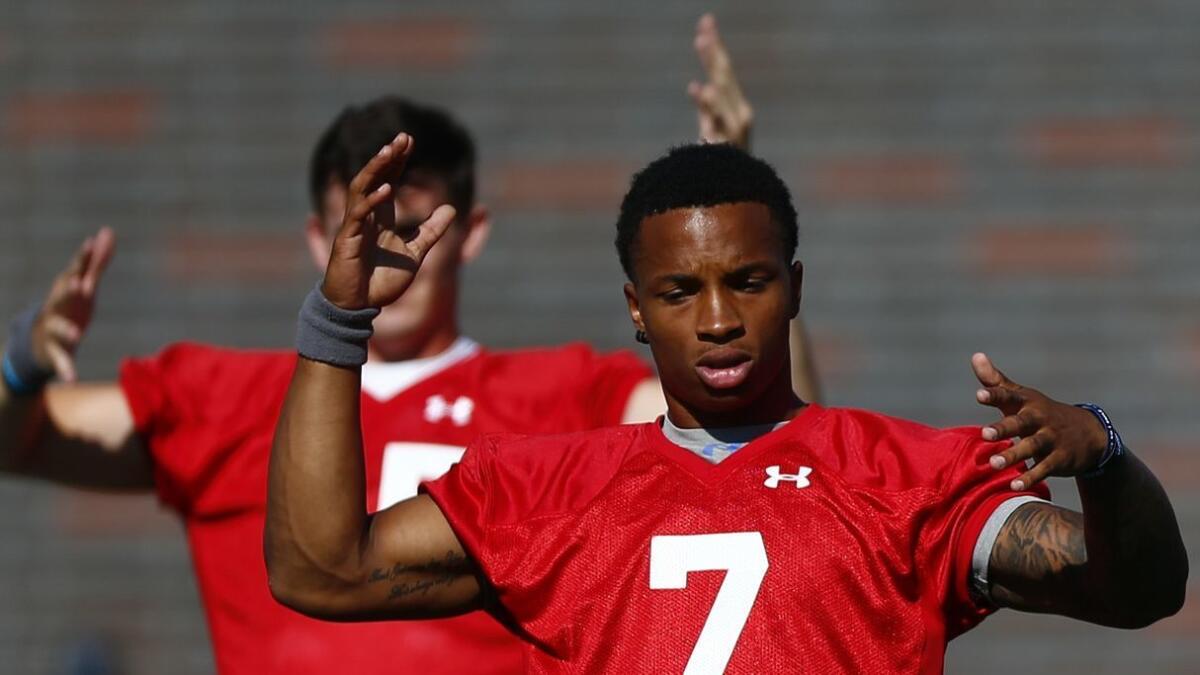What change in redshirt rule could mean for UCLA and other college football teams
- Share via
The idea of sending freshmen into the game never appealed much to Pat Fitzgerald.
During his early years coaching at Northwestern, he tended to keep them on the bench. Even as a linebacker in the mid-1990s, he didn’t like jumping right into action his first season.
“I was one of those below-average guys,” he recalled. “And it was not a very good experience for our defense when I was out there.”
But times change and Fitzgerald has joined a chorus of voices praising a shift in NCAA policy that could give college football a significantly younger look this fall.
The modification involves “redshirting,” a practice by which coaches keep freshmen under wraps for a season — practicing with the team but not playing — to let them mature before their eligibility clock starts ticking.
Barring a medical exemption, merely stepping onto the field used to burn an entire year. Now, players can appear in as many as four games and still redshirt.
That might not sound like a big deal, but it opens an array of possibilities for athletes and coaches.
“That’s not what I’m focusing on. I’m trying to play,” said Dorian Thompson-Robinson, who is battling to start as a first-year quarterback at UCLA. “But it’s cool.”

Technically, athletes can redshirt at any point in their career, though it usually occurs at the start.
Football’s brute, physical nature requires many teenagers to develop physically before competing at the Division I level. NCAA rules give them five years to play four seasons and coaches like to make use of that extra time.
Now that freshmen can preserve their eligibility while getting a few games under their belt, the scenario changes.
“It’s given me a pause to look at our schedule in preseason camp,” Notre Dame coach Brian Kelly said. “I’m eager to kind of give the freshmen much more of an opportunity to compete.”
At Penn State, the staff classifies new players as camp progresses. The “green” category will definitely see regular-season action and the “red” group probably won’t play at all. The new rule could most impact “yellow” players who fall somewhere between.
“You want to get them out there and see what they can do,” coach James Franklin said. “So we’ll try to do that early in the season with two games. Typically home games.”
Other players might need time to acclimate. That’s where motivation comes into play.
Freshmen who know they will redshirt are vulnerable to letting down in practice. They now have reason to work hard because coaches might plug them into the rotation at some point.
“I definitely see where it could have been used in my situation,” said Clelin Ferrell, a junior defensive end at Clemson. “If the coaches felt like I was ready to play toward the second half of the year that I redshirted, then, yeah, that would have been a great tool to have.”
A tool that should mean fewer headaches for coaches.
If they decide to play a freshman early and it doesn’t work out, he can be pulled back with his eligibility intact. Players slated to redshirt can be put in a few games so they don’t grow impatient and transfer to another school.
Teams will have flexibility with another common situation. Say a starting receiver and his backup are dealing with nagging injuries late in the season. Coaches used to agonize over using a freshman to give them a break.
“We throw him out there and he plays pretty well for a couple games, then those older guys get healthy and come back,” Stanford coach David Shaw said. “We burned his redshirt.”
NCAA leaders hope that veteran players will feel less pressure to play through sprained ligaments and torn muscles. That might be especially relevant in the smaller Group of Five conferences, where teams have less roster depth.
“This is not just for my benefit and for the coaches’ benefit,” Shaw said. “This is for the benefit of the young people.”
There is one possibility that was specifically excluded from the new rule: Recruits cannot graduate high school early, enroll in college mid-year, play in a bowl game and then redshirt.
While it remains to be seen how other issues play out, coaches already are talking about additional steps.
Franklin wants travel rosters expanded beyond 70 because teams have more bodies at their disposal. Washington State coach Mike Leach wants the NCAA to slim its thick manual by allowing five seasons of eligibility.
“There are so many rules lately,” he said.
For now, Fitzgerald is simply concerned about managing the situation “the right way.”
Twenty years have gone by since he played at Northwestern, rebounding from that less-than-positive freshman experience to become the greatest linebacker in school history.
Now that he is back at his alma mater, running the program, he sounds like a true believer in the redshirt policy.
“I’m fired up about that rule,” he said. “I think there are a lot of coaches in the country excited about it.”
Times staff writer Ben Bolch contributed to this story.
Follow @LAtimesWharton on Twitter
More to Read
Go beyond the scoreboard
Get the latest on L.A.'s teams in the daily Sports Report newsletter.
You may occasionally receive promotional content from the Los Angeles Times.











